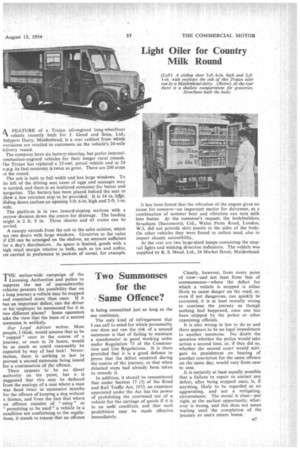Two Summonses for the Same Offence?
Page 41

If you've noticed an error in this article please click here to report it so we can fix it.
THE nation-wide campaign of the Licensing Authorities and police to iuppress the use of unroadworthy vehicles presents the possibility that on a long journey a vehicle may be stopped and examined more than once. If it has an important defect, can the driver or his employer be summoned for it in two different places? Some operators take the view that the issue of a second summons is unlikely.
Our Legal Adviser writes: Most people, I think, would assume that to be " copped " once in the course of a journey, or once in 24 hours, would be as much as could reasonably be expected by way of bad luck! Nevertheless, there is nothing in law to prevent a second summons being issued for a continuation of the offence.
There appears to be no direct authority on the point, but it is suggested that this may be deduced from the analogy of a case where a man was fined twice in successive months for the offence of keeping a dog without a licence, and from the fact that where an offence consists of " using " or "permitting to be used" a vehicle in a condition not conforming to the regulations, it stands to reason that an offence is being committed just so long as the use continues.
The only kind of infringement that I can call to mind for which presumably one does not run the risk of a second summons is that of failing to maintain a speedometer in good working order under Regulation 73 of the Construction and Use Regulations. It is there provided that it is a good defence to prove that the defect occurred during the course of the journey, or that when detected steps had already been taken to remedy it.
In addition, it should be remembered that under Section 17 (3) of the Road and Rail Traffic Act, 1933, an examiner appointed under the Act has the power of prohibiting the continued use of a vehicle for the carriage of goods if it is in an unfit condition, and that such prohibition may be made effective immediately. Clearly, however, from every point of view—and not least from that of commonsense—where the defect for which a vehicle is stopped is either likely to cause danger on the road, or, even if not dangerous, can quickly be corrected, it is at least morally wrong to continue the journey as though nothing had happened, once one has been stopped by the police or other examining officials.
It is also wrong in law to do so and there appears to be no legal impediment to another summons. No doubt the question whether the police would take action a second time, or, if they did so, whether the second court would mitigate its punishment on hearing of another conviction for the same offence on the same day, would vary from case to case.
It is certainly at least equally possible that a failure to repair or correct any defect, after being stopped once, is, if anything, likely to be regarded as an aggravating, and not a mitigating, circumstance. The moral is clear—put right, at the earliest opportunity, whatever is wrong, and this does not mean waiting until the completion of the journey or one's return home.




























































































